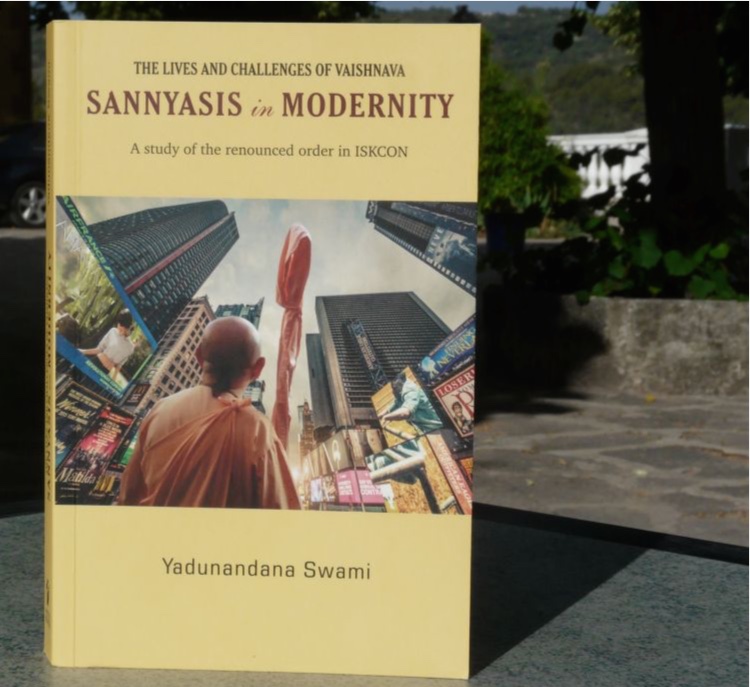New Book Tackles Challenges of ISKCON Sannyasis
By Madhava Smullen | Jul 07, 2017

The sannyasa ashram, or renounced order, is extremely influential in ISKCON. A high percentage of the society’s Governing Body Commission (GBC) members are sannyasis; while the majority of ISKCON’s initiating gurus are too. Yet a large proportion have fallen by the wayside over the years, struggling to maintain their monastic vows.
In his new book “The Lives and Challenges of Vaishnava Sannyasis in Modernity: A Study of the Renounced Order in ISKCON” Yadunandana Swami takes an uprecedently honest look at these challenges.
The principal of Bhaktivedanta College for many years, he began his research for the book as an MA dissertation in order to learn more before taking sannyasa himself in 2009.
“It is important that we do a constructively self-critical study of the sannyasa ashram,” he says. “Especially because of the level of influence it has in ISKCON.”
Through anonymous interviews with nineteen current and former sannyasis, he explores their struggles, and the reasons why they have left or remained in the sannyasa order. He also offers some helpful suggestions for ISKCON leaders to implement, to create a brighter future for the sannyasa ashram.
One of the factors that has led to struggles, according to his interviews, was that many ISKCON sannyasis, especially in the early days, took sannyasa at a very young age. While at the time they may have felt strong, committed, and inspired by Srila Prabhupada’s personal presence, when Prabhupada left this world, and they had to face personal and institutional challenges, they were not able to sustain their vows.
Midlife crisis also created challenges, with some sannyasis wondering later in life if it was actually a lifestyle they wanted to follow after all. “Sometimes in our youth we think we can do everything, and then when we become more mature in age, we tend to reconsider – what do I want to do with the rest of my life?” says Yadunandana Swami.
He adds, “If the sannyasa ashram is going to be so influential in terms of guruship, guidance, initiation and missionary work, then it would be better to have a policy that sannyasa is given at a later age in life.”
Also detrimental were immature motivations for becoming a sannyasi. “For example, taking sannyasa for having a position of respect within the organization, and not for serving the community of devotees,” says Yadunandana Swami. “Some of the ex-sannyasis I interviewed were very candid in admitting that they took sannyasa for pride. That of course is bound to bring problems in the future.”
Another factor that caused problems was loneliness, and a lack of deep personal relationships and spiritual support. Many sannyasis experience what some religious communities call being “alone at the top.” Because they don’t have sufficient close, personal friends they can trust, they can’t confide about their challenges to get help, out of fear that they may be judged.
Their fears are not unfounded. According to Yadunandana Swami, ISKCON culture exhibits a lack of maturity in dealing with individuals’ personal challenges. “One anonymous Swami, who is an influential figure in ISKCON, told me that he went to his godbrothers for personal help and support, and they posted everything on the Internet,” he says. “Now he doesn’t go to his godbrothers for help anymore.”

The cover of Yadunandana Swami’s book
All these factors, Yadunandana Swami says, can be learned from as we move forward.
In his book, he also gives several suggestions for ISKCON leadership to consider implementing.
One is to create a peer counseling system for sannyasis that is supportive and does respect confidentiality.
Another, as mentioned previously, is to only award sannyasa when the candidate is at a mature age. The ISKCON Sannyasa Ministry currently requires most candidates to be over forty, while the average age is fifty.
“Some of my interviewees recommend taking sannyasa after sixty,” says Yadunandana Swami.
Another suggestion is systematic education of sannyasa candidates, as well as ongoing training and research after taking sannyasa. In medieval times, dharma sastras were written for sannyasis based on the scriptures. Yadunandana Swami recommends that a dharma sastra, contextualized for modern times, be written for contemporary sannyasis.
The dharma sastra could guide sannyasis as to what boundary lines they shouldn’t cross, and educate general members of ISKCON on these boundaries too.
It could define what is accepted for preaching – Srila Prabhupada used many modern facilities to forward the mission of Lord Chaitanya – and what is not appropriate, in terms of personal comfort or personal assets.
Following the path of medieval Vaishnava works like Yadavaprakasha’s Yati Dharma Samuchaya, it could provide an updated guide on how sannyasis should rectify their mistakes according to the gravity of the mistake, or if there is scope for rectification at all.
“Of course, such a dharma sastra would require deep research and thorough discussion amongst ISKCON leaders,” Yadunandana Swami says. “It may take many years to produce. But it would be very useful for future generations, so that the sannyasa ashram does not become just a privileged ashram that people want to be in for the wrong reasons. Rather, it should be an ashram full of surrender and sacrifice.”
Not all the responsibility lies only with the sannyasis themselves. Yadunandana Swami also recommends a healthier organizational culture in ISKCON with preventative patterns of behavior that facilitate successful sannyasis and benefit the community.
One thing for devotees in general to guard against is treating sannyasis like performing celebrities. “One of the sannyasis I interviewed said that he sometimes felt like a dancing bear,” Yadunandana Swami says. “When he went to the temple, some devotees expected him to be a celebrity and to dance. But maybe he didn’t feel like dancing – maybe he wanted to remember Krishna in a more quiet mood.”
“Another part of a healthy organizational culture,” Yadunandana Swami continues, “Is that we don’t assume that because somebody took sannyasa, that person is automatically a paramahamsa (pure devotee), and everybody deals with him as if he was a paramahamsa. That is unhealthy for the sannyasi, and it’s unhealthy for the community.”
One more important consideration is for disciples to not approach their sannyasi guru for advice in their marital life. “Not that there can’t be any rare exceptions, but in general it is not appropriate for sannyasis to deal with marital issues,” says Yadunandana Swami. “For that, disciples should approach mature grihastas or experienced marriage counselors.”
Elsewhere in his book, Yadunandana Swami gives a historical analysis of the practice of sannyasa from classical times to modernity, and an explanation of how sannyasa has evolved in ISKCON over the years.
He acknowledges that the ashram has improved a lot from its beginnings in ISKCON to today, with a much more thorough vetting process and “much fewer” sannyasis falling from the path in the last twenty years.
“Still, I think that number needs to diminish more,” he says. “If we give the sannyasa ashram the amount of respect and consideration we do according to tradition and ISKCON culture, that amount of respect should be proportional to the level of success of the ashram. Otherwise to me it doesn’t make sense.”
He ends the book by giving Srila Prabhupada the last word.
“The two main purposes of the sannyasa ashram for Srila Prabhupada was spreading Krishna consciousness throughout the world; and dedicating mind, body and words to the service of the Lord,” he says.
So far, several senior Vaishnavas have commended Yadunandana Swami’s book, including Jayadvaita Swami, Krishna Ksetra Swami (who wrote the forward), and Chaitanya Charan Das, who called it “sobering and instructive.”
“I hope it will be useful for devotees,” Yadunandana Swami concludes. “I think the realizations shared in it can help us to be self-critical, to learn from the past and to improve our contemporary sannyasa ashram.”
* * *
“The Lives and Challenges of Vaishnava Sannyasis in Modernity” is available for purchase here: https://blservices.com/product/sannyasis-in-modernity/












